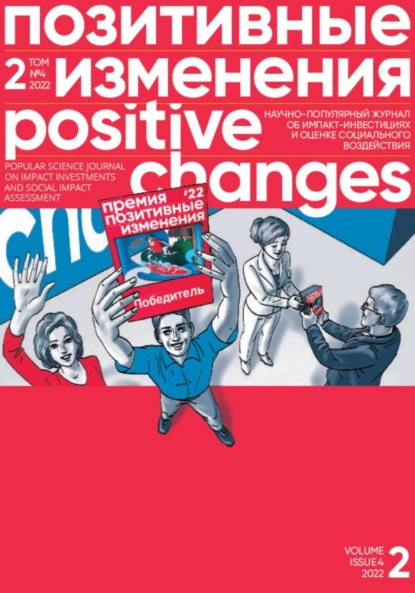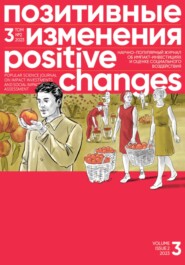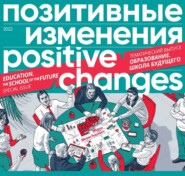По всем вопросам обращайтесь на: info@litportal.ru
(©) 2003-2024.
✖
Позитивные изменения. Том 2, №4 (2022). Positive changes. Volume 2, Issue 4 (2022)
Настройки чтения
Размер шрифта
Высота строк
Поля
Mikhail Shevelev, director of the Alliance of Initiative Budgeting Consultants, also notes the need for a proactive attitude on the part of the public: “In this format, projects are created and implemented together, in a participatory manner, rather than with someone breathing over one's neck and giving instructions for execution. If we consider initiative budgeting in relation to budgetary relations, the interaction between the government and the society, this is the case when the government manages certain territories together with the people. It doesn't even manage, but transforms the life and the place in a way that is convenient, comfortable and interesting for those living there.
TRUST: A PREREQUISITE OR CONSEQUENCE?
The whole technology of initiative budgeting is designed so as to ensure that the authorities and the public hear each other: with its help, an official can show any resident what local self-governance is, how the city is managed and what the limitations are. “After all, the public doesn't need to know all the intricacies of the law, which can be very complicated. And so in the course of solving a particular problem faced by the local community, the official has an opportunity to explain how everything works, in layman's terms, and the resident has an opportunity to understand what conditions need to be met to make this particular area comfortable for life,” Mikhail Shevelev says.
He notes that, in principle, the main result of initiative budgeting is not about solving the problem, but the trust that arises between all the process participants living in a particular territory. And in order for trust to emerge between government representatives and society, the citizens' involvement must not stop with merely taking their opinions into account. “You know how it often happens? “We let you vote, you voted, and we did what you voted for.” The thing is, you haven't given us the opportunity to discuss the options, or the time to go into the essence of what you're going to do, or a chance to present our own options,” the expert continues. “And then again, you want us to thank you for doing what you are supposed to do as part of your job duties. Sorry, but it doesn't work that way.”
Of course, building a dialogue based on trust between officials and the residents, or between local residents themselves, is no easy task at all.
“Initiative budgeting is based on discussion,” Nikolai Plyusnin, a member of the Alliance of Initiative Budgeting Consultants, agrees. “In order to do something, we have to agree and unite, but it is really hard to connect people who are very different from each other.” But when all these nuances are worked out, and the work is based not on fear but on conscience, taking into account modern technology and scientific knowledge of the initiative budgeting, very high results are obtained, the experts agree.
In particular, Plyusnin says, a large sociological study was conducted in Kirov after five years of IB practices, which included a question about trust in the regional, district and local authorities. The researchers found that trust in the authorities in the territories without IB had not increased at all, and in areas where IB was practiced, the trust level increased significantly.
At the same time, Vladimir Vagin does not consider trust to be a primary element in the process, because people go into initiative budgeting primarily because they have a problem that needs solving, not because they want or can negotiate with someone. “The resident understands that he or she can solve their problem courtesy of the state, although that implies meeting a number of conditions and procedures that the state has put forward in order to do so. This is the root cause, and trust develops merely as a result of joint activities.”
SAME MECHANISM FOR CITIES AND SMALL TERRITORIES?
In this regard, it seems that this practice is easier to implement in small urban settlements or villages, where people have closer personal and intimate relationships than in large cities, and the problems they have are very relatable.
“When people live close to each other, it is easier for them to get together and do something good: lighting a street, paving a road, erecting a monument or, for example, setting up a hiking trail. This becomes a good reason for joint positive action,” says Nikolai Plyusnin.
In addition, villages often have a larger number of social and infrastructural problems. And the opportunity for residents to change their living conditions through personal participation, without waiting for the authorities to include a particular locality in some kind of program, becomes a very big growth driver, because people see that they can finally have the power to influence something.
In a couple of years, when all the urgent problems are done with, through IB with active participation of the public, the residents generally move to the next level and begin to improve the infrastructure or come up with more complex, original and exclusive projects.
But, of course, for any unity to be possible, first of all, there must be someone who is willing to take on all this work, and secondly, you need quality infrastructure: a voting platform, mobile or landline Internet for the residents, availability of consultants on initiative budgeting, facilitators and meeting moderators. In Russia, this may be common in large cities; but villages and rural areas still leave a lot to be desired.
But here we have the opposite situation: the city, with its good infrastructure and big budgets, can show poor results in initiative budgeting. This is a result of lower levels of public engagement in the life of their yard, street or city.
“I keep saying that initiative budgeting is not about money at all. Money is only the means for educational work. Thanks to initiative budgeting, responsible residents are educated. This brings about passionate citizens, who are eager to participate in the affairs of their cities. The question of money is secondary,” Vladimir Vagin says. “For example, Moscow has been given a huge number of free-for-all facilities like Zaryadye Park, so what? Does this mean that Muscovites have become more educated citizens who are willing to consciously take on subsequent use of these gifts? Do they understand what the cost of these facilities to the city budget was? Have they created and maintained some forms of joint community activities? Nothing of the kind.”
The lack of responsibility for facilities donated or “handed down from above” is a problem that, of course, is not peculiar for the city – it can also arise in the villages, where the level of cohesion between residents is higher. In order to prevent this from happening, residents of any settlement, regardless of the size of the territory, must be included in the project work, and they must have a working channel for communicating with the authorities.
“The problems that exist in the local courtyard or suburban areas, which are part of Moscow and the Moscow Region, are quite big, because local residents do not have the tools to talk to the authorities in the same language,” adds Mikhail Shevelev. “All they can do is file a complaint and get a response. Neither the residents nor the authorities have a tool to build relationships wherein the local community will also responsible for its decisions.”
Of course, there are successful IB practices in large cities, the expert adds. “I can quote the example of the Kirov Region and St. Petersburg, which find the right forms of working with the residents, in which individual activists and self-organized groups of citizens unite. For example, cyclists in St. Petersburg come up with projects by delegating their representatives to the budget committees. They present these projects at the committee meetings and implement them on behalf of the entire cycling community.”
“In large cities, for greater efficiency, it is possible to launch projects related to the current agenda”, says Natalia Shapovalova, senior researcher of the NIFI Center for Initiative Budgeting under the Russian Ministry of Finance. “Initiative budgeting is still not a universal practice for all residents. In large cities, many communities are excluded from the decision-making process, such as the migrants or people with disabilities. So I would shift the focus from territories to specific social areas and target groups, which have the potential for applying IB – health care and patients, universities and students, schools and students.”
IS A WORLD BASED ON INITIATIVE BUDGETING A UTOPIA OR ESSENTIAL REALITY?
Today, initiative budgeting is the most effective engagement technology, aimed at improving the efficiency of state municipal governance. This tool is expected to retain its leadership position for some time to come. How long this will last, however, is difficult to predict, the experts believe.
Vladimir Vagin does not deny that another technology may emerge that will prove even more effective. “However, knowing how much effort, time and resources have been spent on making initiative budgeting appear in Russia, I think that it is unlikely that something like this will appear in the near future,” the expert reckons. “Therefore, speaking about the future of initiative budgeting, I can assume that this tool will soon become an integral part of the state policy and will be present everywhere.”
Recently, a new Initiative Budgeting Development Strategy until 2030 was presented at the 4th All-Russian Conference on Initiative Budgeting held on September 29–30, 2022[38 - Initiative budgeting. (2022). Summary of the results of the IV All-Russian Conference on Initiative Budgeting. Retrieved from: https://budget4me.ru/articles/nificonference/podvedeny-itogi-iv-vserossiyskoy-konferentsii-po-initsiativnomu-byudzhetirovaniyu-/. (accessed: 01.12.2022).]. The draft strategy developed by NIFI includes five main directions for the development of initiative budgeting:
• integration of IB into state programs and national projects;
• development of territorial public self-governance, including with the help of IB;
• co-financing of IB with taxes;
• development of school and youth IB;
• financial integration and budget literacy.
Figure 1. Indicators of initiative budgeting development in Russia
Based on the monitoring data of the initiative budgeting development in the subjects of the Russian Federation and municipalities for 2018–2021
Source: Financial Research Institute of the Ministry of Finance of the Russian Federation
Natalia Shapovalova also notes a possible territorial vector for the development of this tool. “It is impossible for a single IB practice, no matter how convenient and effective it is, to cover all of the people's needs. Especially if we view them not as an abstract mass of population, but as a combination of communities or target audiences, which makes it necessary to build comprehensive systems of territorial public involvement, building participatory ecosystems at the city, region and country level.”
“Along with the possible prospects of scaling up to the whole of Russia, there is also an objective risk of discrediting the very idea of initiative budgeting,” Mikhail Shevelev warns.
“Our country is set up in such a way that when an order is given top down, and the people on the ground have no understanding of what to do about it, they tend to imitate frenzied activity. For example, the president says that 5 % of the local budget must be spent on interactive practices like initiative budgeting, with direct consideration of the public opinions. So practices began to appear in many regions, for which funds began to be allocated. However, this allocation of funds is not accompanied by proper education, training, and responsible involvement of the residents in the process. In some practices, there are both money and residents' initiatives, but no one has actually seen them,” Shevelev adds.
According to the expert, what is happening is the so-called “dreaming up” of projects within the administration and wishful thinking. Cases like these may be “seriously discrediting the very idea of initiative budgeting, the basic principle of which is that if there is no initiative, there is nothing to support.”
“It is also worth remembering that this tool only works if the authorities are willing to trust people,” says Nikolai Plyusnin.
“After all, what is the most global essence of this process? People themselves choose what they want to do, they choose how they want to do it, they themselves participate in implementing the project, in acceptance of the project, and in its operation. Initiative budgeting only has a great future when the citizens are ready to trust each other and the officials, and when the government is also ready for this.”
Экспертные статьи / Expert Publications
Меняющие мир на «Планете»: возможности краудфандинга для развития территорий
Один из современных инструментов развития территорий – краудфандинг, народное финансирование. На крупнейшей в России краудфандинговой платформе Planeta.ru значительную часть проектов составляют кампании региональных активистов, которые объединяют людей и сообща реализуют инициативы на местах: благоустраивают парки, открывают новые удобные городские пространства, развивают сельские территории. Как работает краудфандинг и чем он может быть полезен?
Наталия Игнатенко
PR-директор краудфандинговой платформы Planeta.ru
ЛОКАЛЬНЫЙ МЕМ
Само слово «краудфандинг» нередко вызывает вопросы и сложности в написании или произношении – отсюда на Planeta.ru и появился локальный мем «крауд-чота-там». Он отражает одну из проблем индустрии народного финансирования – проблему самоидентификации. Многие слышали, что краудфандинг – это «что-то про сбор денег в интернете». На самом деле это лишь часть определения. Краудфандинг отличается от благотворительности и складчины тем, что каждый проект ограничен конкретной финансовой целью и сроком. Автор сам до запуска кампании просчитывает, сколько средств ему необходимо для реализации инициативы и в течение какого времени он сможет собрать эти средства. Важное правило краудфандинга заключается в возвратности: если за указанный срок деньги не удалось привлечь, платформа возвращает их в полном объёме вложившимся участникам, а проект признаёт неуспешным.
Большинство краудфандинговых платформ во всём мире работают по принципу «всё или ничего»: автор получает собранные средства, только если достигает заявленной финансовой цели в полном объёме. Но на Planeta.ru более лояльные условия, учитывающие особенности российского менталитета, поэтому успешным может быть признан проект, собравший не менее половины от финансовой цели. Как объясняет учредитель и сооснователь Planeta.ru Фёдор Мурачковский, в России краудфандинг часто работает как краудсорсинг, то есть привлечение не денег, а ресурсов. За время промо-кампании проекта (а без неё не получится собрать средства) вполне могут найтись люди, готовые вложиться в него «руками».
Так, например, авторам проекта «Галерея домовой росписи Прикамья» удалось собрать 282 тысячи рублей из заявленных 500 тысяч, но они считают свой проект успешным даже не наполовину. Из соцсетей и СМИ о новой точке на культурной карте Соликамска узнавали большие компании и частные меценаты, которые тоже активно включались в обустройство будущей галереи. Одна компания предоставила музею технику, другие подарили напольное покрытие и сантехнику, третьи сделали существенную скидку на монтаж освещения. Во всём этом важный вывод: краудфандинг – это не только сбор средств, но и отличный пиар-инструмент, который позволяет рассказать об идее ещё на стадии задумки, объединить вокруг неё сообщество и оценить её востребованность.
За поддержку краудфандинговых проектов люди получают нефинансовые вознаграждения – различные бонусы, так или иначе связанные с будущим проектом. Если автор хочет выпустить с помощью народного финансирования книгу, логично предложить её экземпляр за поддержку. Если планирует открыть инклюзивное кафе, можно дать людям возможность заранее оплатить там чашечку кофе. Если решил отремонтировать какое-то общественное пространство, можно пригласить участников проекта на вечеринку там же. При этом возможность получить вознаграждение – не единственная и часто не основная мотивация. Люди участвуют в таких инициативах ещё из чувства сопричастности, симпатии или уважения к организаторам кампаний. По данным исследования Planeta.ru, 34 % пользователей поддерживают проекты из желания решить проблему. Рассказываем, как сообща удалось это сделать в нескольких регионах.
МЕДОВЫЙ ТУРЫШ
Социальный предприниматель Гузель Санжапова – одна из самых известных героинь российского краудфандинга. В 2013 году она запустила свой первый крауд-проект, чтобы помочь отцу, получившему в наследство пасеку в деревне Малый Турыш Свердловской области. Гузель придумала взбивать мёд и добавлять в него лесные ягоды. Так родилось семейное предприятие «Малый Турыш» (до ребрендинга Cocco bello), где стали работать жители деревни. С тех пор Гузель успешно завершила ещё шесть крауд-кампаний с общей суммой сбора 9,5 млн рублей. Три последние кампании Санжаповой на Planeta.ru посвящены строительству в деревне общественного центра – это современное здание в 850 квадратных метров, где будут пекарня, магазин, пространство для образования и туристический хаб. Девушка признаётся, что раньше думала, что её бизнес про мёд, «но на самом деле он про развитие территории, а мёд – только одна из частей, которая нужна для решения более глобальной задачи».














